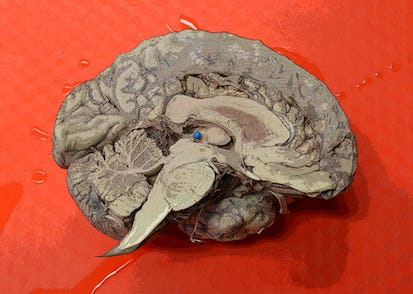- Level Foundation
- المدة 28 ساعات hours
- الطبع بواسطة The University of Chicago
-
Offered by

عن
Learn how the nervous system produces behavior, how we use our brain every day, and how neuroscience can explain the common problems afflicting people today. We will study functional human neuroanatomy and neuronal communication, and then use this information to understand how we perceive the outside world, move our bodies voluntarily, stay alive, and play well with others.الوحدات
Introduction to the Course
3
Videos
- Introduction: The Bauby Story
- Ethics and Brain Science
- I Am a Patient
The Nervous System
2
Videos
- The Four Functions
- Central Anatomy
Neurons
6
Videos
- Meet the Stars: Neurons
- Parts of the Neuron
- Neuronal Uniqueness: Stars of the Sky
- Glial Cells
- Myelin
- Demyelinating Diseases
Central Nervous System vs Peripheral Nervous System
3
Videos
- Meninges
- Peripheral Diseases
- Brain Tumors
The Nervous System Labs
3
Videos
- The Brain and the Spinal Cord
- Meninges
- Brain Tumors
Review
1
Readings
- In-Video Quiz Questions and Answers
1
Quiz
- The Nervous System
Additional Resources
2
Readings
- Clinical Vignette: Brain Tumor
- Additional Resources
Introduction to Neural Communication
3
Videos
- Electrical Language
- Electricity Review
- Action Potential
Neurotransmitters
7
Videos
- Neurotransmitter Synthesis
- Neurotransmitter Release
- Clostridial Toxins: Botox
- Signal Termination
- Receptors
- Metabotropic Receptors
- Wrap-Up: Neurocommunication
Embodied Emotion
7
Videos
- Introduction to Embodied Emotion
- Enteric Nervous System
- Parasympathetics & Sympathetics
- Parasympathetic/Sympathetic Balance
- Autonomic Pharmacology: Adjusting the PS/S System
- Spinal Cord Injury
- Wrap-Up: Embodied Emotion
Review
1
Readings
- In-Video Quiz Questions and Answers
1
Quiz
- Neurocommunications
Additional Resources
2
Readings
- Additional Resources
- Optional Survey on MOOCs
Early Brain Development
7
Videos
- Introduction to Neuroanatomy
- Neural Tube Formation
- Neural Tube Defects
- Brain Vesicles
- Expansion of the Cerebral Cortex
- Two Forebrain Tracts
- Cerebral Palsy
Neuroanatomy
6
Videos
- Nerves
- CNS Regional Functions
- Hemisphere Functions
- Aphasia
- Language Circuits
- Making a Flat Schematic of the Brain
Lesions
4
Videos
- Oxygen and Cerebral Blood Flow
- Blood Supply
- Strokes and Tumors
- Bleeds
Neuroanatomy Labs (optional - contains sensitive graphic elements)
9
Videos
- Spinal Cord
- Inside the Cranium
- Telencephalon
- Cortex
- Cerebellum
- Visual Pathway
- Pituitary Tumors
- Blood Supply
- Hippocampus & Alzheimer's Disease
Review
1
Readings
- In-Video Quiz Questions and Answers
1
Quiz
- Neuroanatomy
Additional Resources
1
Readings
- Additional Resource
Perception
7
Videos
- Introduction to Perception
- Sensory Interpretation: Optical Illusions
- Sensory Interpretation: Auditory Illusions
- Sensory Interpretation: Weber's Law
- Stimulus Set
- The Road to Perception
- Name the Senses
Getting Light to the Retina
4
Videos
- The Visual Pathway
- Distance Vision
- Near Vision + Near Triad
- Emmetropization
Turning Light into Neural Information
4
Videos
- Light Path
- Rods and Cones
- Central Vision
- Color Vision
Interpreting the Optical World
3
Videos
- Visual Fields
- The Importance of Edges
- Visual Perception
Learning to See
1
Videos
- Learning to See
Sheep Brain Labs (optional - contains sensitive graphic elements)
7
Videos
- Sheep Brain vs Human Brain
- Sheep Cerebellum
- Sheep Brain Parts
- Sheep Brainstem
- Sheep Ventricles, pt.1
- Sheep Ventricles, pt.2
- Sheep Spinal Cord & Cauda Equina
Review
1
Readings
- In-Video Quiz Questions and Answers
1
Quiz
- Perception and Vision
Additional Resources
2
Readings
- Clinical Vignette: Albinism
- Additional Resources
Introduction to Hearing
2
Videos
- Introduction to Hearing
- Experiences of Hearing Loss
How It Works
5
Videos
- Hearing Pathways
- External Ear
- Rinne Test
- Middle Ear
- Inner Ear
Cochlear Amplifier
5
Videos
- Cochlear Amplifier
- Outer Hair Cell Motility
- Otoacoustic Emissions
- Hearing Loss
- Weber and Rinne
Interpretation of Sound Information
4
Videos
- Expectation: Interpreting Sound
- Prosody
- Communication
- Wrap-up: Hearing
Review
1
Readings
- In-Video Quiz Questions and Answers
1
Quiz
- Hearing
Additional Resources
2
Readings
- Clinical Vignette: One Man's Story of Hearing
- Additional Resources
Peripheral Vestibular Apparatus
3
Videos
- Introduction to Vestibular Sense
- The Vestibular Stimulus
- Canals and Otoconial Masses
Vestibular Physiology
5
Videos
- Hair Cell Orientation
- Yoked End Organs, Part 1
- Yoked End Organs, Part 2
- Otoconial Disorders
- Visual Integration
Vestibulo-Ocular Reflex (VOR)
4
Videos
- The VOR Is Fast
- Horizontal VOR Circuitry
- Nystagmus
- Adapting the VOR
Gaze Control
4
Videos
- Eye Movements
- Saccades
- Saccade Circuits
- Controlling Saccades
Review
1
Assignment
- The Vestibular Sense & Gaze
1
Readings
- In-Video Quiz Questions and Answers
Additional Resources
1
Readings
- Additional Resources
Introduction to Voluntary Movement and the Motor Hierarchy
4
Videos
- Introduction to Voluntary Movement
- Motor Hierarchy
- Problems with Motor Hierarchy
- Motor Modulation
Muscles and Motoneurons
4
Videos
- Fast and Slow Fibers
- Motoneuron Types
- Orderly Recruitment
- Exercise and Muscle Mass
Stretch Reflex
3
Videos
- Monosynaptic Reflex
- Co-activation
- Gamma Reflex Loop
Automatic Movements
3
Videos
- Posture
- Postural Control
- Central Pattern Generator
Self-Generated Movements
4
Videos
- Intro to Self-Generated Movements
- Praxis
- Emotional Movements
- Wrap-up
Review
1
Readings
- In-Video Quiz Questions and Answers
1
Quiz
- Voluntary Movements
Additional Resources
1
Readings
- Additional Resources
Introduction to the Cerebellum
6
Videos
- The Data-Driven Cerebellum
- The Purkinje Cell
- Cerebellar Functions
- Cerebellar Topography
- Cerebellar Laterality
- Efference Copy and Sensory Reafference
Cerebellar Learning
3
Videos
- Cerebellar Learning and the VOR
- Extreme Vestibular Plasticity (optional)
- More Cerebellar Learning
Introduction to the Basal Ganglia
4
Videos
- Action Selection
- Basal Ganglia Anatomy
- Basal Ganglia Pathways
- Basal Ganglia Experiment (optional)
Basal Ganglia Function
6
Videos
- Operational Learning
- Chunking
- Parkinson's Disease
- Non-Motor Functions of Basal Ganglia
- Cerebellum and Basal Ganglia Cooperation
- Wrap-Up: Voluntary Movement, part 2
Review
1
Readings
- In-Video Quiz Questions and Answers
1
Quiz
- Motor Modulation
Additional Resources
1
Readings
- Additional Resources
Anatomy and Hormones
4
Videos
- Introduction to Homeostasis
- Hypothalamic Anatomy
- Pituitary Gland & Gigantism
- Post-Partum Mood Disorders
Thermoregulation
3
Videos
- Thermoregulation
- Hyperthermia
- Fever and Hot Flashes
Breathing, Urination, and Sleep
6
Videos
- Breathing
- Urination
- Problems with the Urination System
- Sleep Phenomenology
- Sleep Mechanisms
- Wrap-Up: Homeostasis
Review
1
Readings
- In-Video Quiz Questions and Answers
1
Quiz
- Homeostasis
Additional Resources
1
Readings
- Additional Resources
Abstract Function, Emotion, and Attention
4
Videos
- Introduction to Abstract Function
- Bauby and Emotion
- Thalamic Attention
- Mushroom Hunting
Introduction to Memory
4
Videos
- Memory Types
- PTSD
- Semantic Memories
- Episodic Memories
Memory Loss
4
Videos
- The Story of H.M.
- Memory Formation Circuitry
- Hollywood Amnesia
- Clinical Amnesia
Language and Disability
4
Videos
- Introduction to Language
- Aphasias
- Prosody
- Intellectual Disability
Final Thoughts, Thank You, and Farewell
2
Videos
- Your Brain, Your Illness
- Future Challenges
Review
1
Readings
- In-Video Quiz Questions and Answers
1
Quiz
- Introduction to Abstract Function
Final Project
1
Peer Review
- Final Project
Additional Resources
1
Readings
- Additional Resources
Auto Summary
Unlock the mysteries of the human brain with "Understanding the Brain: The Neurobiology of Everyday Life." This foundational course, offered under the Science & Engineering domain, is designed to delve into the intricate workings of the nervous system and its role in shaping behavior. Guided by expert neuroscience instructors, learners will explore functional human neuroanatomy and neuronal communication, gaining insights into how we perceive the world, control our movements, and interact socially. Spanning 1680 minutes of in-depth content, this course is ideal for those curious about the brain's influence on daily life and common neurological issues. Flexible subscription options, including Starter, Professional, and Paid plans, make it accessible for a wide range of learners. Whether you're a student, professional, or simply intrigued by neuroscience, this course provides a comprehensive and engaging learning experience. Join us on Coursera and start your journey into the fascinating world of the brain today!

Peggy Mason

